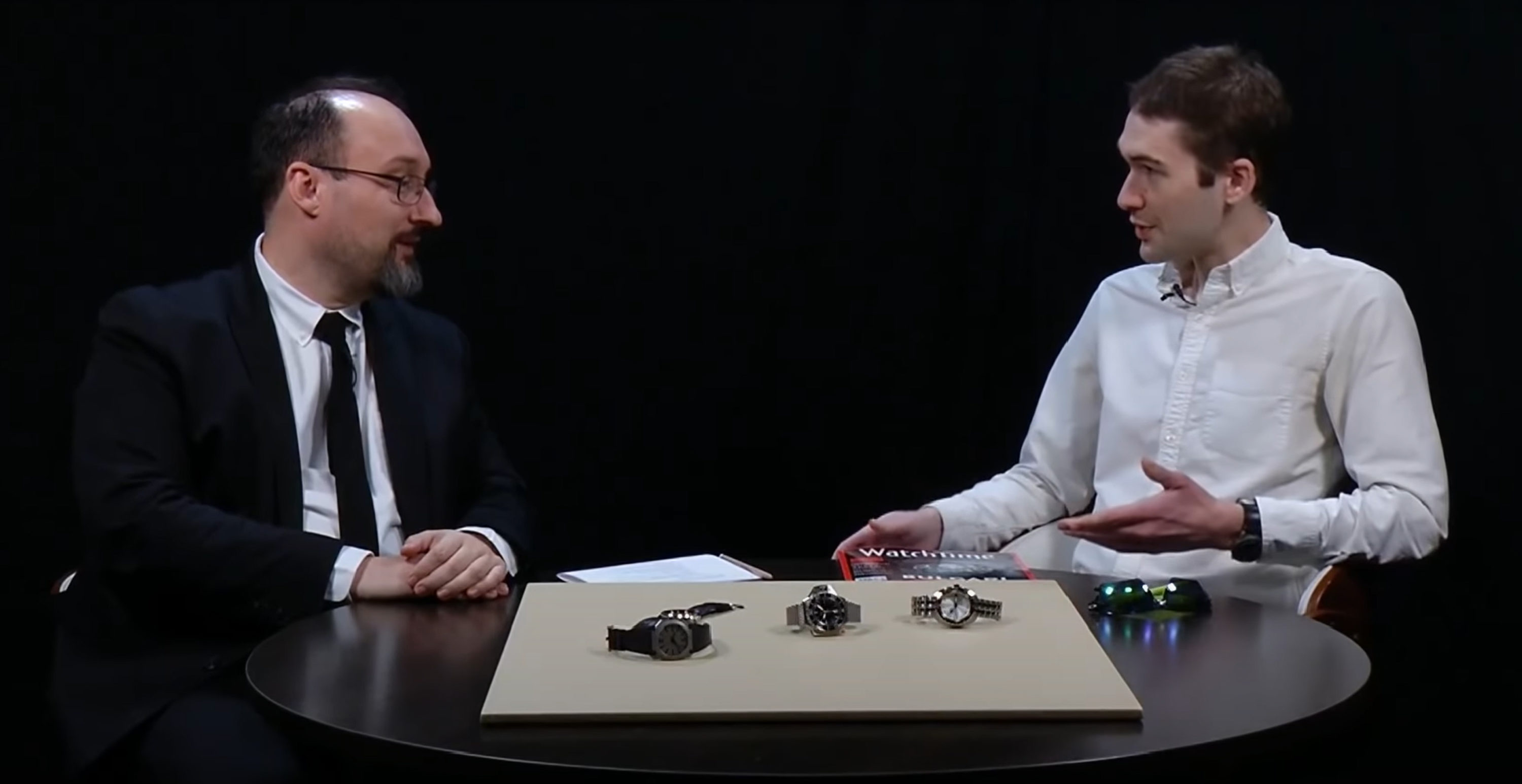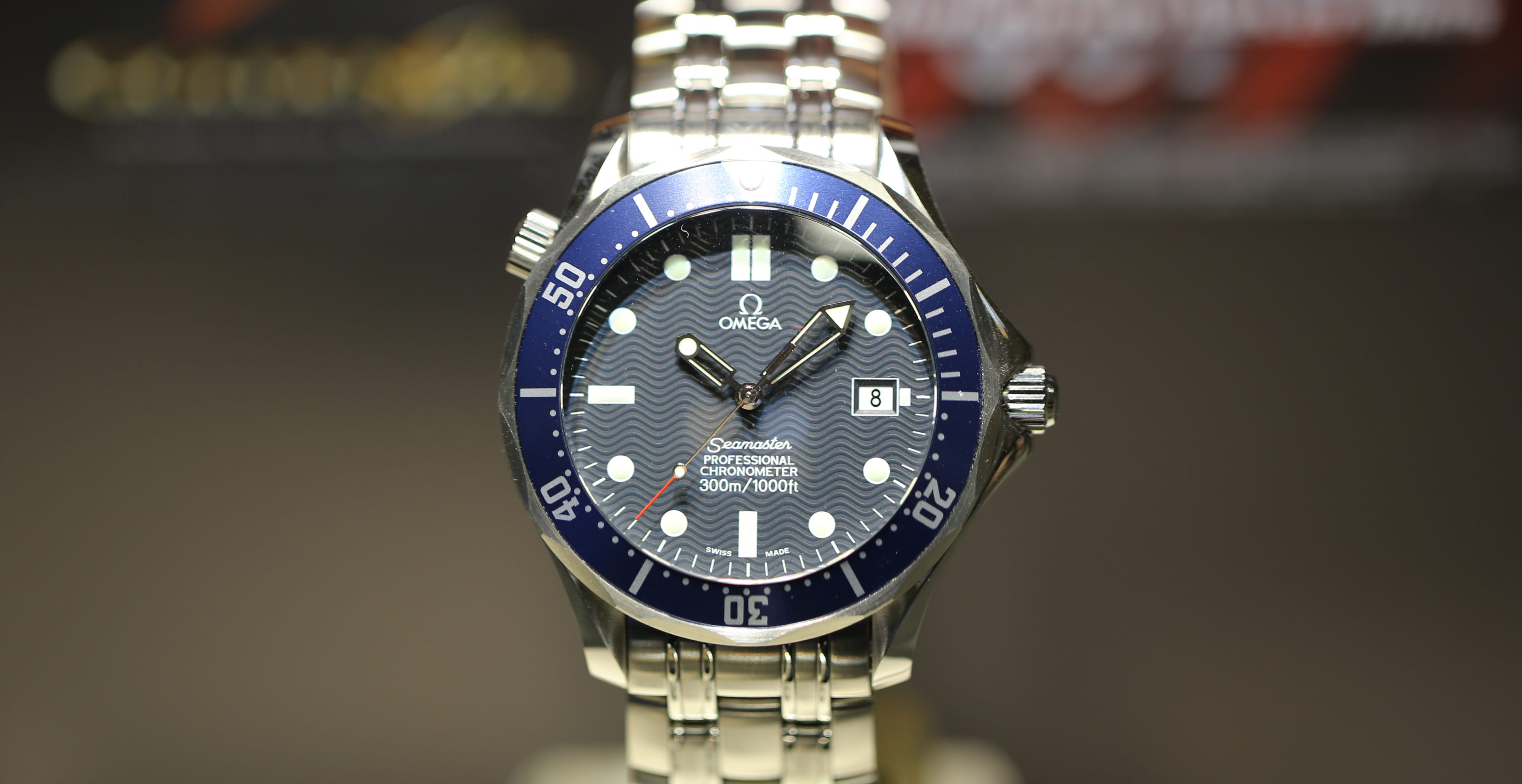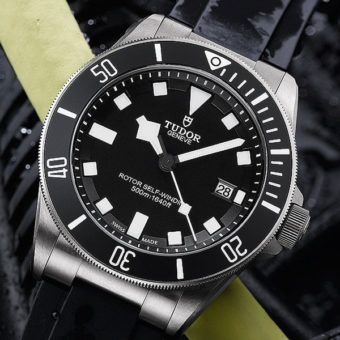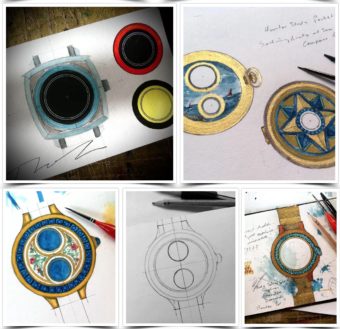WatchTime’s Roger Ruegger caught up with self-described “perpetual student” Tim Mosso, “a watch collector, writer, historian of modern watchmaking, and a voice for the global community of watch enthusiasts,” and perhaps best known as the Director of Media at pre-owned specialist Watchbox, for which he and his team have created more than 6,000 videos.

Pictured above: Ruegger (l) and Mosso (r) during a “Collector Conversation” in 2020.
“I don’t chase subscriptions, views, likes, or even monetize my videos. I need to sell watches – not monetize YouTube views.“
Tim Mosso, Director of Media & Watch Specialist for Watchbox
What is the main challenge in managing thousands of followers?
When a YouTube channel is more like an encyclopedia than a tabloid, it tends to attract users who are well behaved, mature, and sincerely interested in the topic at hand. For the most part, they police themselves. At this point, we’re up to 172,000 on my primary channel, “WatchBox Reviews.” Setting the tone for an online community is essential, because it determines what kind of crowd you’re going to attract. Anyone who resorts to negative, sensational, self-centered, or vulgar messaging to gain fast followers inevitably creates a monster. That kind of audience turns on creators, eats itself alive, and ruins your business case. I’ve heard that there’s a ton of ill will and politics in the YouTube watch community, but I avoid it by never interacting with other channels. I don’t chase subscriptions, views, likes, or even monetize my videos. I need to sell watches – not monetize YouTube views. A measly 2,000 views on a video of a $500,000 watch is fine if it sells the watch. I keep the message positive, focus on the facts at hand, and leave it to the viewer to decide whether a timepiece is right for them.
What is the one thing people usually don’t know about Watchbox?
Our proficiency in product and service runs deeper than many recognize. We’ve been buying and selling preowned watches for 22 years. From 2001 to 2017, we were known as Watch-U-Want, and we were one of the first preowned watch specialists to operate online and at scale. Combining with Govberg’s preowned business in 2016, we launched our ultimate form, and WatchBox has existed as a brand name since November 2017.
Can you tell us a little bit about your audience? Who’s usually watching?
Sometimes, even I wonder. Just this week, I was stopped on the street by Hong Kong security services during my first trip to the city. What appeared to be a really bad day in the making turned into a request for photos and wrist shots. As far as the data are concerned, I have a few quantified facts about my viewers. First, it’s a lot of dudes; 96.3 percent of my audience is male. In terms of age, 76 percent of the viewers are between 25 and 55. It’s also a very international crowd, since only 26 percent of my audience is located in the United States. When I record my live web show, we have live viewers from locations as disparate as Iran, Hong Kong, and South Africa. Some of these locations are half a day removed from my local time, so I always appreciate my overseas viewers who make that commitment. We’re translating my videos for the Chinese market these days, so I’m eager to know how I play on Chinese domestic social media. You could call it my “final frontier.”
The most memorable watch you got to handle?
I’m going to preface this by noting that my favorite and most memorable watches rarely are the most expensive ones. The F.P. Journe “Souscription” Tourbillon Souverain likely was the most valuable. All watches of that 20-piece series are worth several million dollars. I’ve experienced multiple “piece unique” models, and that’s hard to beat for rarity. The Gérald Genta Grande Sonnerie wasn’t necessarily a piece unique, but it was close enough. It was the world’s most expensive watch in its day thanks to a combination of a perpetual calendar, power reserve indicator, grande et petite sonnerie, minute repeater, tourbillon, and automatic winding. For good measure, the movement was extravagantly engraved by hand. In that, the max-option configuration, the Genta Grande was a $1 million watch in 1994 money. And being a no-guardrails 1990s Genta design, its oddball appearance looks delightfully alien from a 2020s perspective.
Do you know by now what type of content works better, or what type isn’t performing as good as you’d like?
Clickbait works. That’s why there are entire YouTube and Instagram accounts that do nothing but talk about Rolex, Seiko, and certain steel AP and Patek models. Algorithmic bonus points are awarded for outrageous video titles featuring these brands. While that’s sustainable as a model for a channel, it’s also boring. Sadly, creators know that anger, division, and malice also attract massive attention. That is not sustainable in the long run. Too many YouTubers indulge in this quick fix, but, like the Sith, they’re destined for a bad end. Any time I need to talk about oddities like DeWitt, Nord Zeitmaschine, a non-diving Blancpain, or pretty much any yellow gold dress watch, I must set my expectations low. Also, algorithms don’t love small brands, and even F.P. Journe videos underperform relative to the success of the brand itself. There just aren’t a ton of users online searching to buy even the most feted indie brand watches. Furthermore, thumbnails need to show the actual watch in large, colorful, and prominent fashion. Indulgent “art project” thumbnails that look great on a full-scale computer monitor become incomprehensible pixel vomit on the palm-sized screen of a phone.
Who had the biggest impact on you?
Shannon Beck was the President of Watch-U-Want in 2014, and she was the person who gave me my start with the company. I spilled coffee on her during the interview and still got the job, so she was definitely looking deep beneath the surface of the goofy guy asking for a PR role. Watch-U-Want didn’t have a large budget for salaried employees, so I’ve always been grateful that she took a chance on me. Also, I need to mention Danny Govberg. If you’ve ever seen my face on social media or at a live event, that’s Danny. He was the one who pushed me to expand to interviews, commentary, and features beyond hands-on reviews.
In hindsight, what has been your favorite video so far?
The interviews with Philippe Dufour and David Walter stand out. In Dufour’s case, I was humbled that he even agreed to speak with a YouTuber working in the aftermarket. He was generous with his time, friendly, and thoughtful. I was thrilled that the video itself also performed well, and its success without clickbait helped to restore my faith in the online watch community.
My interview with David Walter was another highlight. First, he’s one of the greatest living watchmakers. But nobody has heard of the guy since he doesn’t advertise, barely has a web presence, and spent most of his career making clocks. Walter works entirely with hand tools and doesn’t even use CAD technology for modeling – even Dufour uses CAD for concepting his watches. Walter is part of a generation of watchmaking giants including his peers George Daniels, Derek Pratt, and Anthony G. Randall. Walter generally makes watches only when asked, and his focus on clocks means his technical chops are as overlooked as those of Swiss automaton specialist François Junod or Chinese complicated clock ace Xu Jiabao. My podcast interview with Walter spanned an hour of discussion that covered everything from his apprenticeship in western Australia to his recently renewed U.S.-based focus on watches. We talked about watchmaking for two hours after I stopped recording, and I found the experience to be inspiring.
Who would you like to sit down with?
Walt Odets. I learned so much from him and the technical guides he published online 20 years ago. But I barely know who he was beyond the byline, and I’ve never met anyone who claimed to know him firsthand. Walt, if you’re out there, please find me.
Looking back, what made you choose the watch industry in the first place?
I’ve always loved machines, and watches are among my longstanding interests. After leaving the Navy in 2013, I gave myself a few months to determine whether a job in the watch industry was a realistic goal or a dead end. After writing web copy for several vendors, I’d at least proven to myself that there was income to be made without direct work in sales. Watch-U-Want president Shannon Beck took a chance based on my Navy PR resume, hired me in 2014, and I never looked back.
The one watch you will never sell?
My grandfather’s retirement watch – an Omega De Ville. He was wearing it when he died, and it’s inscribed with a note from “Remington Electric Shaver” commemorating his retirement in 1973.
Your first ‘real’ watch?
It’s an Omega Seamaster Diver 300M from 2002. The watch was a graduation present from my extended family. The reference 2531.80.00 turned into something of a celebrated model due to its (thoroughly sponsored) James Bond links, and I have to admit that a younger version of me thought that was pretty cool. My SMP is still in the collection.

What watch would you buy if money were no object?
The 2006 De Bethune DBD. It’s a linear-calendar watch with a jumping hour, spherical moonphase, and a love-it-or-hate-it design. Even as an unapologetic fanatic for this model, I understand the perspective of critics who deride it as a tombstone or a bathroom scale. None of that matters to me, and I’m well into sell-a-kidney territory should an example in white gold surface. De Bethune only made 17 in white gold, so I suspect my redundant organs are safe.
What’s your golden rule when buying watches?
Make sure that the watch is unforgettable, arresting, and intoxicating TO YOU. If you can walk away, change the subject, and quell the fever, it wasn’t meant to be. If you require peer pressure or constant social media reinforcement to stay interested, forget it. On the other hand, if you find yourself dreaming about the thing and fantasizing involuntarily, that’s a pretty good sign you have a match.
What makes a watch collectable in your opinion?
“Collectible” is different from “investment.” I believe that a watch is collectible if an identifiable community of enthusiasts rises around the model. Collectors are the key to collectability. There are passionate online and offline communities dedicated to things like the 1971 Tissot Astrolon and the 1982 Omega Seamaster “Black Tulip.” Neither one is an investment in any sense of the word, but you can have endless hours of fun finding, discussing, and sharing photos of them with other fans.
Do you have a favorite complication?
I believe that the alarm is the most useful complication. That said, I’m emotionally drawn to calendar watches. Perpetual calendars are the ultimate in that regard, and they seem almost like magic. A Patek Philippe 5236P would be my dream perpetual calendar watch, and it’s not beyond imagination to make that happen.
The watch you should never have bought, or sold?
I wish I hadn’t sold my platinum Jaeger-LeCoultre Master Grande Memovox. It was both an – excellent – alarm and a perpetual calendar. As far as non-buyer’s remorse, I regret not buying the original Omega Speedmaster X-33 when I was in the Navy. There was a military purchase program for the watch that endured for several years after public sales ended. I could have had the watch for a few hundred dollars new-in-box with a full set. You just had to promise not to sell it immediately. So yeah, that was a missed opportunity.
What do you think is the biggest challenge for the industry?
Servicing watches costs too much and takes too long. Sometimes, the most touted high horology and boutique independent brands are the worst in this regard, so the price of service has no bearing on the quality of service. This isn’t 2023 specific, but it’s a definite problem collectors will face this year. As far as current events, I see recession fears, geopolitics, and the collapse of the crypto scene denting demand for expensive products of all descriptions. From an industry standpoint, I can see the role that crypto money and “wealth effect” spending had on the inflation of several mainstream watch models from late 2020 to early 2022. Now that the sugar high has passed, we’re seeing realignment of demand with supply and lower prices. It’s not a collapse or a burst bubble, but the pullback is real. Economic currents in Europe, the U.S., and China will determine whether further retreats or sustainable demand define watch sales in 2023.
If you could change one thing in the watch industry, what would it be?
To better serve the watch buyer with neither connections nor seniority, I would like to see a split between allocated new watches reserved for VIP clients and a pool of watches to be allocated by a random drawing. Granted, every authorized dealer has a list of “whales” who always get first right of refusal for the hottest AP Royal Oak, Patek sport watch, Rolex, or other hype watch. That’s fine. But take some portion of the production and make it available by random drawings to regular folks who are willing to wait in line and write checks. Historically, this was done in the 19th and early 20th century. Philippe Dufour also used a similar approach for allocating his Simplicity 20th Anniversary. This doesn’t create a unique risk of flipping or secondary market dumping, because everyone already knows that guys on the dealers’ elite lists are reserving delivery of watches specifically to flip them. With plenty of dealer-whitelisted buyers simply saying “yes” to everything they’re offered with a view to a quick sale, the incremental risk of offering purchase opportunities to randomly drawn clients poses no additional risks to a brand.
What’s next for Tim Mosso?
Hopefully, I’ll be able to make meaningful strides in watchmaking. I’m working with our watchmakers after hours and on weekends, and I’ve slowly assembled the elements of a bench in my house. This is a longstanding goal, but it’s a tough one to square with extremely full days on the marketing side. I have no illusions about building watches or putting my name on the dial. But I want technical proficiency to pair with the knowledge base I’ve built over the last eight years. Repairing, servicing, and preparing watches would take me to a level of understanding I’ve never had. It’s the “PhD” to the “undergraduate” understanding I’ve acquired so far. It’s humbling, challenging, and rewarding when progress is made.







Tim Mosso is the one of the best reviewers in the watch market industry on YouTube. He is a “walking encyclopedia” of knowledge when it comes to brands– both major and independent — watch maker history, and the the people at the watch makers. Tim also discusses the non-hyped watches on Instagram and how own Instagram channel that offer an amazing amount of value for all types of collectors. If Tim puts his “Mosso-stamp-of-approval” on a model, you can take it to the bank that it is a watch to enjoy & own!
Like many collectors, I love what Tim Mosso brings to the community… humor, deep-cut knowledge, a next-gen vocabulary and some of the wittiest descriptions that are often re-quoted about watches and the people that wear them. My favorite example is what he said about wearing a yellow Tudor Fastrider with a suit … only do it if “you are a savant in the art of irony”. Well said professor Mosso.
I loved this interview and the excellent questions that Roger Ruegger asked Tim. Tim Mosso is one of the most knowledgeable people you can meet when it comes to mechanical watches, brands (both known and indies), what makes them unique, watch industry history, and the who’s-who in the watch industry going back to the early 19th century.
I sincerely refer to Tim as a walking encyclopedia of watch industry knowledge. I can’t tell you how much I have learned just listening to Tim for over 5 years now. And best yet, Tim willingly shares his knowledge with anyone willing to listen to his YouTube channel and his watch reviews on Instagram.
I was elated to see that WatchBox recognized Tim’s talent and came up with a contract to keep him onboard for the next 5 years!
Danny Simenauer